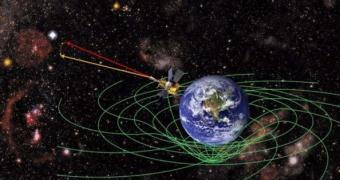Nearly a century ago, famed physicist Albert Einstein described what is now known as the frame-dragging effect. Years later, the American space agency launched a mission to test the idea, and its data were interpreted as successful. New investigations are now seeking to determine whether they truly are.
In his theory on general relativity, the expert predicted the fact that rotating space bodies with a large mass – planets, stars and more massive structure – drag spacetime around them. This phenomenon was termed frame-dragging.
Its existence was inferred from the theory by Austrian physicists Josef Lense and Hans Thirring back in 1918, and so the phenomenon is also called the Lense–Thirring effect. Detecting it is however a tremendously complex task.
The dragging is about one part per trillion, which means that scientists needed to either analyze a very massive object – a gas giant, a star or a black hole – or build a very accurate satellite.
On April 20, 2004, a Delta II rocket took off to space carrying the Gravity Probe B (GP-B) mission, which consisted of a spacecraft designed specifically to detect frame-dragging around Earth.
The data it sent back by the end of its flight mission, in 2005, showed that the effect did not perceivably exceed the level of background noise in the satellite's detectors.
Further refinements in calculation, conducted in December 2008 at NASA, reduced the degree of uncertainty related to the existence of the effect to less than 0.5 percent, from 15 percent in August 2008, Universe Today reports.
The main rationale behind the GP-B mission was to encase several gyroscopes in materials that would isolate them from external influences. The satellite itself was designed to fly around these components.
Given that Earth deforms spacetime due to gravity and that it also spins, then objects in its orbit should theoretically be slightly drawn into the direction in which it rotates.
But the spin axis of the onboard gyroscopes were shifted by only 6,606 milliarcseconds per year, whereas experts had predicted a change of 41 milliarcseconds per year.
At this point, the international scientific community is still debating whether the spacecraft managed to discover the effect or not. Finding it would basically prove Einstein's theory from yet another point ov view.
Lately, physicists have been thinking of new ways to test general relativity, by modeling white holes, searching for Hawking radiation, and simulating how the laws of physics break down when two black holes collide.

 14 DAY TRIAL //
14 DAY TRIAL //